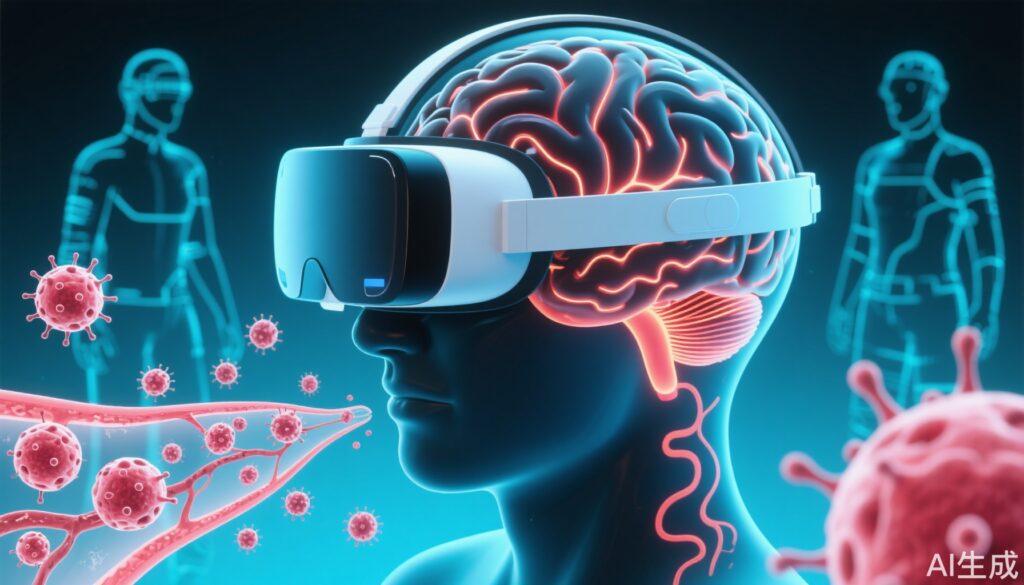Highlights
- Groundbreaking evidence: Visual exposure to virtual infection can trigger measurable immune responses in healthy adults.
- Neural-immune interface: The human brain rapidly processes visual threats and activates immune mechanisms before any real pathogen contact.
- Translational potential: Findings may inform applications in PTSD therapy, vaccine enhancement, and age-related immune vulnerability.
Study Background and Disease Burden
The human immune system has long been viewed as a reactive force—mobilizing only after pathogens breach physical barriers. However, clinical encounters and public health crises have hinted at a subtler interplay: Why do some individuals experience physiological stress and even immune changes merely upon witnessing signs of illness? Understanding the anticipatory mechanisms linking the brain and immunity is not only of theoretical interest but may impact the management of infectious disease outbreaks, psychological disorders, and the design of preventive interventions.
Study Design
In a landmark study published in Nature Neuroscience (July 2025) by researchers from the University of Lausanne and University of Geneva, 248 healthy volunteers aged 18–49 were enrolled. Each participant donned a virtual reality (VR) headset and was exposed to three types of digital avatars: 1) healthy individuals, 2) people displaying fearful expressions, and 3) overtly infected individuals with visible skin lesions and herpes-like eruptions. The avatars gradually approached the participant from five meters to about 30 centimeters. Throughout the exposure, high-density EEG measured brain activity, blood samples were analyzed for innate lymphoid cell (ILC) subpopulations, and a separate cohort received an influenza vaccine to serve as a ‘real infection’ comparator.
Key Findings
The results were striking and have major implications for neuroimmunology:
1. Rapid Neural Detection: EEG data revealed that when a virtual ‘infected’ avatar approached within one meter, the parietal and premotor cortices—regions responsible for integrating spatial and sensory information—showed specific activation within 150 milliseconds. This anticipatory neural response occurred an order of magnitude faster than typical tactile-triggered reactions.
2. Immune Activation Mirroring Real Infection: Notably, blood samples drawn immediately after VR exposure showed significant changes in ILC subpopulations. Specifically, ILC1 (often associated with early antiviral responses) declined, suggestive of peripheral migration, while ILC2 and ILC precursor cells proliferated. The magnitude of these changes was not statistically different from those observed in the real influenza vaccine group, underscoring the biological relevance of the virtual exposure.
3. Mechanistic Insights: The team employed a multi-modal approach:
– EEG decoding demonstrated that the brain distinguishes between infectious and non-infectious avatars at distance, relying on the peripersonal space (PPS) network—traditionally involved in collision avoidance, here repurposed as a ‘biological radar.’
– fMRI data pinpointed dynamic connectivity between the anterior insula, medial prefrontal cortex, and hypothalamus—the so-called ‘salience network’—which intensified as the infectious avatar approached. Dynamic causal modeling confirmed that this connectivity predicted the degree of subsequent ILC activation.
– Serum analysis via mass spectrometry revealed elevations in HPA axis hormones (cortisol, norepinephrine) and distinct fluctuations in arachidonic acid metabolites, including prostaglandins. An AI model trained on these three biochemical markers could predict individual immune response magnitude with 71% accuracy.
4. Specificity of the Response: Only avatars with visible infectious stigmata triggered this cascade. Avatars with merely fearful expressions did not elicit immune changes, indicating that the brain can differentiate between emotional/social vs. biological threats. Sensitivity to visual cues such as ulcers and exudate may reflect an evolved aversion to signs of communicable disease.
5. Evolutionary Perspective: Lead author Andrea Serino likened this preemptive response to a smoke detector—better to overreact to a benign stimulus than miss a real hazard. This over-cautiousness may have conferred a survival advantage during historical epidemics. The instinct to avoid coughing individuals during pandemics is likely a manifestation of this circuitry.
Expert Commentary
Camilla Jandus, co-investigator, summarized: “The immune system is no longer a lone sentry, but a special forces unit sharing intelligence with the brain.” These findings open new avenues for:
- Psychiatric applications: Individuals with PTSD often display persistent HPA axis activation and chronic inflammation, possibly due to hyperactive threat detection. VR-based exposure therapies might help recalibrate this axis.
- Vaccine design: Traditional vaccines require weeks for adaptive immune responses, whereas neural priming of innate lymphoid cells occurs within minutes. Harnessing ‘neuroimmune priming’ could enhance vaccine efficacy, especially in high-risk groups.
- Geriatric medicine: The next phase will test whether this neural-immune anticipation is preserved in the elderly, where both ILC function and neural threat detection may decline, potentially explaining increased susceptibility to infection.
Conclusion
This study provides the first direct evidence that visual anticipation of infection—without any actual pathogen exposure—can mobilize real immune defenses in humans. The cross-talk between brain and immunity is faster, more specific, and evolutionarily engrained than previously recognized. These discoveries may eventually inform new strategies for disease prevention, behavioral health, and immunotherapy. Future research should address the durability of these responses and their applicability across diverse populations.
References
Trabanelli S, Akselrod M, Fellrath J, Vanoni G, Bertoni T, Serino S, Papadopoulou G, Born M, Girondini M, Ercolano G, Ellena G, Cornu A, Mastria G, Gallart-Ayala H, Ivanisevic J, Grivaz P, Paladino MP, Jandus C, Serino A. Neural anticipation of virtual infection triggers an immune response. Nat Neurosci. 2025 Jul 28. doi: 10.1038/s41593-025-02008-y.



